Showing Spotlights 937 - 944 of 2877 in category All (newest first):
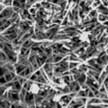 In two new studies, researchers show that cement plants can have their carbon dioxide exhaust eliminated while co-producing carbon nanotubes. They demonstrate that with their C2CNT (carbon dioxide into carbon nanotubes) process, a wide portfolio of tailored carbon nanotubes, such as those with special shapes or conductivity can be made. C2CNT is a straightforward process that transforms CO2 to carbon nanotubes by molten electrolysis with inexpensive (nickel and steel) electrodes and low voltage. This synthesis consumes only CO2 and electricity, and is constrained only by the cost of electricity.
In two new studies, researchers show that cement plants can have their carbon dioxide exhaust eliminated while co-producing carbon nanotubes. They demonstrate that with their C2CNT (carbon dioxide into carbon nanotubes) process, a wide portfolio of tailored carbon nanotubes, such as those with special shapes or conductivity can be made. C2CNT is a straightforward process that transforms CO2 to carbon nanotubes by molten electrolysis with inexpensive (nickel and steel) electrodes and low voltage. This synthesis consumes only CO2 and electricity, and is constrained only by the cost of electricity.
Mar 21st, 2017
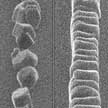 In recent years, researchers working on de-icing and anti-icing strategies have been inspired by biology and nanotechnology to develop nanocoatings and other nanostructured surfaces. Researchers now have demonstrated the ability to spatially control frost nucleation (ice formation from water vapor) and to manipulate ice crystal growth kinetics. This ice nucleation control and the confinement of ice crystal growth direction through manipulating roughness scale have not been reported before.
In recent years, researchers working on de-icing and anti-icing strategies have been inspired by biology and nanotechnology to develop nanocoatings and other nanostructured surfaces. Researchers now have demonstrated the ability to spatially control frost nucleation (ice formation from water vapor) and to manipulate ice crystal growth kinetics. This ice nucleation control and the confinement of ice crystal growth direction through manipulating roughness scale have not been reported before.
Mar 17th, 2017
 Researchers demonstrate a novel mechansim for the realization of an optical waveguide. This opens the possibility to realize a waveguide without any modulation of the refractive index. The optical delay necessary for the beam confinement is not achieved by a local modulation of the speed of light, but through an exotic effect called 'geometric phase'. Geometric phase is a temporal delay associated with changes in the propagation of light polarization, the latter corresponding roughly to the oscillation direction of the electromagnetic field.
Researchers demonstrate a novel mechansim for the realization of an optical waveguide. This opens the possibility to realize a waveguide without any modulation of the refractive index. The optical delay necessary for the beam confinement is not achieved by a local modulation of the speed of light, but through an exotic effect called 'geometric phase'. Geometric phase is a temporal delay associated with changes in the propagation of light polarization, the latter corresponding roughly to the oscillation direction of the electromagnetic field.
Mar 14th, 2017
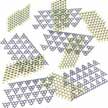 Photodetectors with a spectral response from the ultraviolet (UV) to visible light have significant importance in modern industrial and scientific applications such as imaging, communication, environmental monitoring and day and nighttime surveillance. Compared to other materials, the photo-current conversions of two-dimensional transition metal dichalcogenides such as MoS2 nanosheets are impressive, making them great candidates for next-generation visible light photodetectors. Researchers have now developed a facile and low-cost solution processing strategy to fabricate mechanically flexible 2D organic-inorganic hybrid thin-film photodetectors on a conventional filter paper.
Photodetectors with a spectral response from the ultraviolet (UV) to visible light have significant importance in modern industrial and scientific applications such as imaging, communication, environmental monitoring and day and nighttime surveillance. Compared to other materials, the photo-current conversions of two-dimensional transition metal dichalcogenides such as MoS2 nanosheets are impressive, making them great candidates for next-generation visible light photodetectors. Researchers have now developed a facile and low-cost solution processing strategy to fabricate mechanically flexible 2D organic-inorganic hybrid thin-film photodetectors on a conventional filter paper.
Mar 9th, 2017
 An recent analysis of the combined effect of nanoparticles and substrates on the concentration of mobile ions in liquid crystals considers both 100% pure and contaminated with ions substrates and nanoparticles. The results could be very useful for engineers trying to apply nanotechnology to liquid crystal devices. Specifically, the control of mobile ions in liquid crystals by means of nanoparticles and substrates of the cell tailored for specific applications - liquid crystal displays, light shutters, switches, modulators, etc.
An recent analysis of the combined effect of nanoparticles and substrates on the concentration of mobile ions in liquid crystals considers both 100% pure and contaminated with ions substrates and nanoparticles. The results could be very useful for engineers trying to apply nanotechnology to liquid crystal devices. Specifically, the control of mobile ions in liquid crystals by means of nanoparticles and substrates of the cell tailored for specific applications - liquid crystal displays, light shutters, switches, modulators, etc.
Mar 8th, 2017
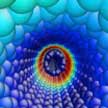 Carbon nanotubes (CNTs), by possessing a uniquely large disparity among its intertube and intratube interaction strengths, have been established as ultralow friction nanostructures and are serving as testbeds for tuning frictional response. In new woirk, researchers now have revealed the phononic origins of friction in CNT oscillators. This work, for the first time, provides a precise connection between individual phonon mode scattering and friction force.
Carbon nanotubes (CNTs), by possessing a uniquely large disparity among its intertube and intratube interaction strengths, have been established as ultralow friction nanostructures and are serving as testbeds for tuning frictional response. In new woirk, researchers now have revealed the phononic origins of friction in CNT oscillators. This work, for the first time, provides a precise connection between individual phonon mode scattering and friction force.
Mar 6th, 2017
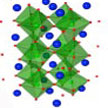 Complex oxide perovskite have been intensively researched for over half a century for their intriguing high temperature superconductivity, thermoelectric, ferroelectricity, colossal magnetoresistance. However, their large band gaps limit their interaction with visible photons. In new work, researchers propose transition metal perovskite chalcogenides (TMPCs) as a new class of versatile semiconductors for optoelectronic applications.
Complex oxide perovskite have been intensively researched for over half a century for their intriguing high temperature superconductivity, thermoelectric, ferroelectricity, colossal magnetoresistance. However, their large band gaps limit their interaction with visible photons. In new work, researchers propose transition metal perovskite chalcogenides (TMPCs) as a new class of versatile semiconductors for optoelectronic applications.
Feb 28th, 2017
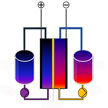 Flow batteries are regarded as one of the most promising energy storage technologies for stationary large-scale storage because the power capability and the energy storage capability of these storage systems can be sized independently, which benefits load balancing, peak shaving, power conversion and stand-alone power system. As an emerging rechargeable battery technology, lithium redox flow batteries (Li-RFB) represent an important advance which is distinct from conventional solid-state rechargeable batteries. Researchers have now demonstrated an all-metallocene-based non-aqueous redox flow battery with stable cycling performance and comparable energy density with current related energy storage technologies.
Flow batteries are regarded as one of the most promising energy storage technologies for stationary large-scale storage because the power capability and the energy storage capability of these storage systems can be sized independently, which benefits load balancing, peak shaving, power conversion and stand-alone power system. As an emerging rechargeable battery technology, lithium redox flow batteries (Li-RFB) represent an important advance which is distinct from conventional solid-state rechargeable batteries. Researchers have now demonstrated an all-metallocene-based non-aqueous redox flow battery with stable cycling performance and comparable energy density with current related energy storage technologies.
Feb 27th, 2017
 In two new studies, researchers show that cement plants can have their carbon dioxide exhaust eliminated while co-producing carbon nanotubes. They demonstrate that with their C2CNT (carbon dioxide into carbon nanotubes) process, a wide portfolio of tailored carbon nanotubes, such as those with special shapes or conductivity can be made. C2CNT is a straightforward process that transforms CO2 to carbon nanotubes by molten electrolysis with inexpensive (nickel and steel) electrodes and low voltage. This synthesis consumes only CO2 and electricity, and is constrained only by the cost of electricity.
In two new studies, researchers show that cement plants can have their carbon dioxide exhaust eliminated while co-producing carbon nanotubes. They demonstrate that with their C2CNT (carbon dioxide into carbon nanotubes) process, a wide portfolio of tailored carbon nanotubes, such as those with special shapes or conductivity can be made. C2CNT is a straightforward process that transforms CO2 to carbon nanotubes by molten electrolysis with inexpensive (nickel and steel) electrodes and low voltage. This synthesis consumes only CO2 and electricity, and is constrained only by the cost of electricity.
 Subscribe to our Nanotechnology Spotlight feed
Subscribe to our Nanotechnology Spotlight feed





